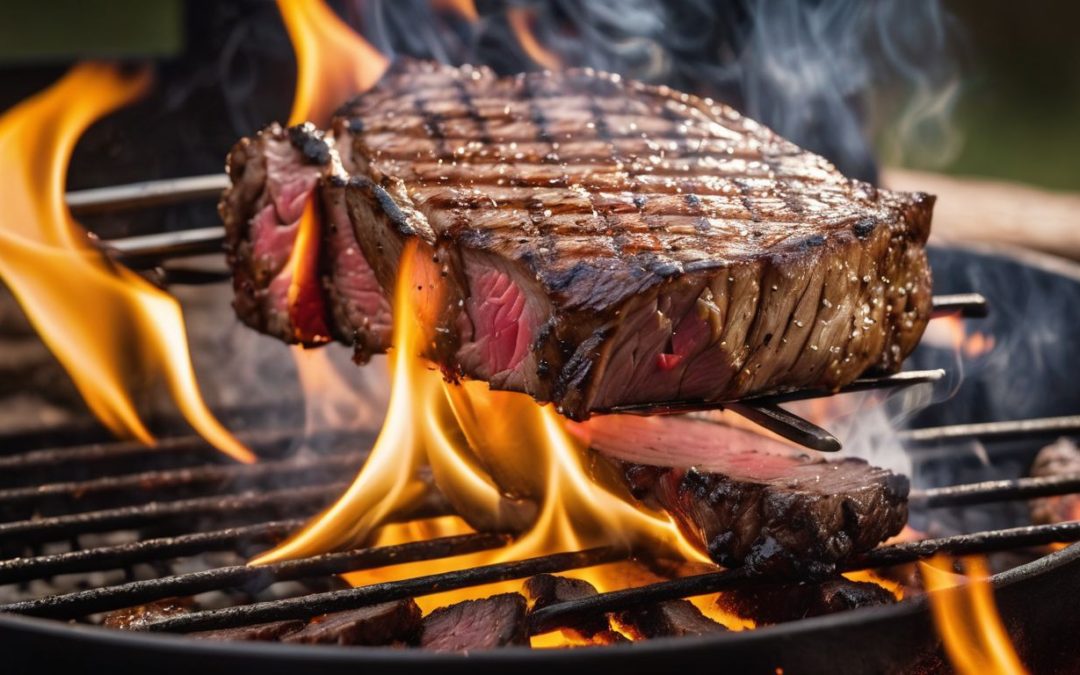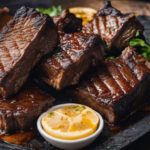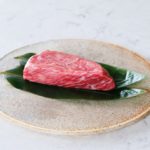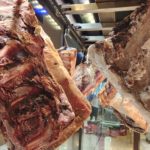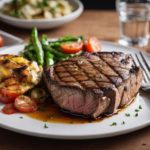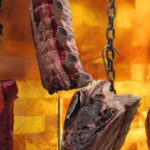Ever stood at the butcher’s counter, torn between ordering dry-aged or wet-aged steak? Trust me, I’ve been there too. In fact, this very dilemma prompted me to dive deep into researching the aging process differences and how they reflect on the taste and tenderness of your juicy steak.
This blog post will walk you through both methods – highlighting their pros, cons and impact on flavor profiles – helping you make an informed decision for your next carnivorous feast.
Stick around; it’s time we beef up our knowledge!
Key Takeaways
- Dry aging involves hanging the meat in a controlled environment to intensify its flavor, while wet aging retains moisture and results in a milder taste.
- Dry – aged steak has a nutty and rich flavor, but it is expensive and not suitable for all cuts of beef.
- Wet – aged steak is more affordable, juicier, and has a fresher flavor profile. It is the preferred method in the beef industry due to its efficiency.
- When selecting aged steaks, consider your personal taste preferences, cut of steak, and availability of dry or wet aged options.
Differences Between Dry Aging and Wet Aging
Dry aging involves hanging the meat in a controlled environment, allowing moisture to evaporate and intensifying its flavor profile, while wet aging typically entails vacuum-sealing the meat with its own juices to retain moisture and achieve a milder taste.
Dry Aging: process, flavor profile, cost
Dry aging is an old method. It involves letting meat sit in a fridge for weeks. The meat takes on a unique flavor during this time. It tastes nutty and rich, like roasted nuts. But it’s not for everyone! There are things to think about before you buy dry-aged steak.
First, it is expensive. Why? Because the process takes up space and needs care over many days. And some of the meat gets too dry to sell or eat during its time in the cooler.
Second, there is less of it at the end than when you started out with fresh beef because of drying loss.
Finally, not all cuts are good for this style of aging – only high-grade beef will do!
But true fans say that every bite is worth these downsides! So while dry-aged steaks cost more, many prefer their distinct taste above all else.
Wet Aging: process, flavor profile, cost
Wet aging is a faster and more cost-effective process compared to dry aging. In wet aging, the steak is vacuum-sealed in plastic and allowed to age for a certain period of time. This method helps retain moisture in the meat, resulting in a juicier steak.
The flavor profile of wet-aged steak tends to be fresher and more vibrant compared to dry-aged steak. However, some people find that wet-aged beef may have a slightly metallic taste and lacks the depth of flavor that comes with dry aging.
Wet aging is the preferred method in the beef industry due to its efficiency and higher yield.
Factors to Consider When Selecting Aged Steaks
When selecting aged steaks, it’s important to consider your personal taste preferences, the cut of steak you prefer, and the availability of dry or wet aged options.
Personal taste preferences
When it comes to choosing between dry aging and wet aging for your steak, personal taste preferences play a crucial role. Some people prefer the earthy flavors that come with dry-aged steak, while others enjoy the fresher and more vibrant flavor of wet-aged steak.
It really depends on what you like! Additionally, if you’re someone who prefers lean cuts of meat, wet aging might be a better option as it helps retain moisture in the meat. On the other hand, if you’re looking for a more intense and concentrated flavor, dry aging is worth considering despite being a slower and more expensive process.
So go ahead and pick based on what your taste buds crave!
Cut of steak
When it comes to aging steak, the cut of meat you choose is an important factor to consider. Different cuts have different levels of marbling and fat content, which can affect how they respond to the aging process.
For example, fatty cuts like ribeye or striploin tend to be more suitable for dry aging because the extra fat helps keep the meat moist and flavorful during the longer aging time. On the other hand, leaner cuts like tenderloin may not benefit as much from dry aging and might be better suited for wet aging, which helps retain moisture in leaner meats.
Ultimately, your personal preference for flavor and texture should guide your decision when selecting a cut of steak for aging.
Availability
When it comes to choosing between dry aging and wet aging for your steak, availability is an important factor to consider. Wet aging is a more common practice in the beef industry because it is efficient and results in higher yields.
This means that you are more likely to find wet-aged steaks readily available at grocery stores or butcher shops. On the other hand, dry-aged steaks may be harder to come by as the process takes time, space, and supervision.
Dry aging requires specific conditions such as controlled temperature and humidity levels, which not all establishments have the capacity for. So if you’re looking for convenience and accessibility, wet-aged steaks might be your best bet.
That being said, there are also options for home dry-aging kits if you want to try your hand at it yourself. These kits provide everything you need to age your steak at home, allowing you to enjoy the unique flavors of dry-aged beef without relying on availability in stores.
Ultimately, whether you choose dry aging or wet aging depends on personal preference and how much effort you’re willing to put into finding or preparing your aged steak.
Comparing the Benefits of Dry Aging and Wet Aging
Dry aging offers enhanced flavor, tenderization, and concentration of flavors due to the evaporation and weight loss during the aging process. Wet aging, on the other hand, retains moisture in the meat, making it a more affordable and accessible option.
Dry Aging: enhanced flavor, tenderization, concentration of flavors
Dry aging is a method that enhances the flavor and tenderness of steak while also concentrating the flavors. During the dry aging process, enzymes in the meat break down proteins, resulting in tenderized meat.
Additionally, as moisture evaporates from the beef, it allows for a more concentrated and intense flavor profile to develop. The end result is a steak with enhanced depth of flavor and a rich, earthy taste that many meat lovers find irresistible.
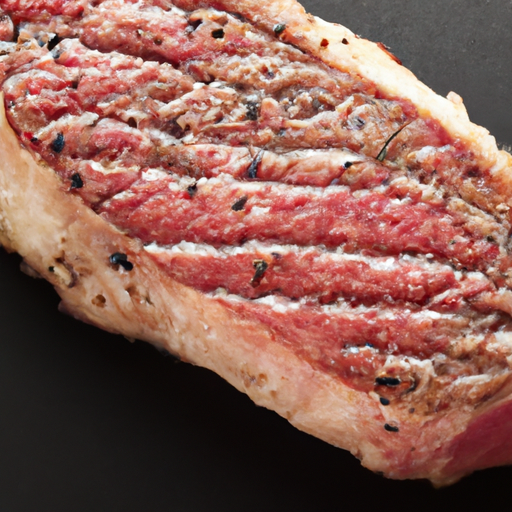
Wet Aging: moisture retention, affordability, accessibility
Wet aging is a great option for your steak because it helps retain moisture, making the meat juicier and more tender. It’s also a more affordable and accessible method compared to dry aging.
With wet aging, the beef is vacuum-sealed in plastic, allowing it to slowly age while retaining its moisture content. This process helps distribute the flavors evenly throughout the meat, giving you a delicious and flavorful steak.
Wet-aged steaks are widely available in supermarkets and butcher shops, making them convenient for anyone who wants to enjoy an aged steak without too much hassle or cost.
Expert Opinions on Dry Aging vs. Wet Aging
Chefs and steak enthusiasts have varying perspectives when it comes to dry aging vs. wet aging, with some preferring the intense flavors and tenderness of dry-aged steaks, while others appreciate the moisture retention and affordability of wet-aged ones.
Factors such as personal taste preferences, cut of steak, and availability also play a role in selecting the right aged steak.
Chefs and steak enthusiasts’ perspectives
As a steak enthusiast, I can tell you that chefs and other meat lovers have different opinions when it comes to dry aging versus wet aging. Some chefs believe that dry aging brings out the best flavors in the meat, giving it a rich and earthy taste.
They think it’s worth the extra cost and time because of the unique depth of flavor it creates. On the other hand, there are also chefs who prefer wet aging because it retains more moisture in the meat, resulting in a juicier and more vibrant flavor.
It really depends on personal preference and what kind of taste experience you’re looking for in your steak.
When it comes to regular steak enthusiasts like myself, I’ve found that there is no one-size-fits-all answer. Some people love the intense flavors that come with dry aged steaks, while others prefer the milder taste of wet aged ones.
There are even some who enjoy both methods depending on their mood or occasion.
It’s important to remember that not all steakhouses offer both options, so availability might be another factor to consider when choosing between dry aging and wet aging. So if you want to try different techniques or see which one suits your palate better, you may need to do some research or visit specific restaurants that specialize in either dry-aged or wet-aged steaks.
Consumer preferences and popular opinions
Now let’s talk about what meat lovers like you prefer when it comes to aging steaks. It turns out that there is no one-size-fits-all answer! Some people enjoy the earthy flavors and tenderness that come with dry-aged steak, while others prefer the fresher and more vibrant taste of wet-aged steak.
It really comes down to personal preference and what kind of flavor profile you’re looking for in your steak.
When it comes to consumer opinions, many people appreciate the enhanced flavor and concentration of flavors that come with dry aging. They love the roasted, nutty taste that develops during this process.
On the other hand, some folks find that wet-aged beef may have a slightly metallic taste and lacks the same depth of flavor as its dry-aged counterpart.
Another factor to consider is affordability. Wet aging tends to be a cheaper option because it doesn’t require as much time or supervision compared to dry aging.
Conclusion: Choosing the Right Aging Method for Your Steak
When it comes to dry aging vs. wet aging, the right method for your steak depends on your personal preference. If you enjoy a more earthy flavor and have the time and space to devote to the process, dry aging might be for you.
On the other hand, if you prefer a fresher, more vibrant taste and want a faster option, wet aging is a good choice. Ultimately, it’s all about finding what suits your taste buds best!
FAQs
1. What is the difference between dry aging and wet aging?
Dry aging involves hanging the meat in a controlled environment with low humidity, allowing it to naturally tenderize and develop flavor. Wet aging involves vacuum-sealing the meat and letting it age in its own juices.
2. Which method of aging produces a more flavorful steak?
Many people prefer the depth of flavor that comes from dry aged steaks as the extended time allows for more intense flavors to develop.
3. Does dry aged or wet aged steak have better tenderness?
Dry aged steaks often have a greater level of tenderness due to the natural enzymatic breakdown that occurs during the aging process.
4. Are there any differences in price between dry aged and wet aged steaks?
Dry aged steaks are generally more expensive than wet aged steaks due to the additional time, care, and storage required for the aging process.
Greetings!
With over two decades of diverse experience in the meat industry, I proudly stand as an expert in all things meat. My journey commenced with a strong foundation in hospitality, where I honed my culinary skills as a chef in prestigious restaurants and on luxurious superyachts worldwide.
However, my true passion lies in the art of butchery. Throughout my extensive career, I have had the privilege of working with renowned meat purveyors and mastering the craft of meat cutting and preparation. From breaking down whole carcasses to meticulously selecting prime cuts, my butchery expertise is at the core of my meat knowledge.
Having immersed myself in various cultures and cuisines, I have honed my skills to deliver exceptional dining experiences, crafting delectable dishes that celebrate the natural flavors of different meats. Whether it's sourcing the finest meats for discerning clients or sharing valuable tips on meat selection and cooking, I take pride in elevating the meat experience for both professionals and enthusiasts.
My journey has taken me from the bustling kitchens of top-rated restaurants to the heart of meat processing facilities, gaining insights and honing my skills to become a true meat connoisseur. Now, I am enthusiastic about sharing my expertise, offering valuable insights on meat selection, cooking techniques, and the art of butchery.

